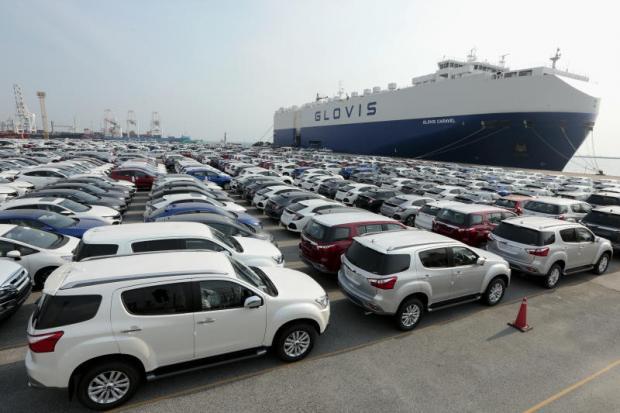[Analytics] Thai’s shippers see export rebound

Cars sit ready for loading onto cargo ships at Laem Chabang port in Chon Buri province. (Photo by Patipat Janthong)
A key shippers group remains hopeful that exports will fare better in the second quarter than the first after a contraction of 1.64% year-on-year in the January-March period, projecting purchase orders to rise seasonally during April-June. Phusadee Arunmas, Wichit Chantanusornisiri specially for the Bangkok Post.
Ghanyapad Tantipipatpong, chairwoman of the Thai National Shippers’ Council (TNSC), said the council forecasts exports to bounce back to flat or 1% growth in the second quarter.
She said a recovery in the economies of the US and China, easing tensions between the two giants and higher fruit shipments will help boost performance in the second quarter.
“We’re still hopeful that the country’s exports will manage growth of 3% for the year, an average of US$22 billion a month,” she said. “This rate is highly possible.”
Ms Ghanyapad said the forecast was based on a foreign exchange rate of 33 baht to the dollar and domestic economic growth of 3.2% this year.
The Commerce Ministry reported on April 22 that Thailand’s exports remained in the doldrums, with the performance in March dropping after an unexpected increase in February.
Customs-cleared exports fell 4.9% year-on-year in March to US$21.4 billion after a 5.9% rise in February to $21.6 billion.
The uptick in February was largely due to a one-time shipment of arms for military drills and the transport of oil-related products and gold.
Without oil-related products, gold and weaponry, exports would have contracted 4.9% in February from the same month last year.
The ministry attributed March’s contraction to a slowdown in global trade and economic growth.
Ongoing trade disputes between the US and China have had direct and indirect impacts, undermining trading partners’ economies, especially those closely related to Chinese supply chains such as Hong Kong, South Korea and Taiwan, the ministry said.
For the first quarter of 2019, exports registered a contraction of 1.6% from the same period last year to $61.98 billion.
Imports for the period contracted by 1.2% from the same quarter of last year, totalling $59.98 billion.
In related news, the council proposed that the new government support developing Thailand as the centre of farm product processing and exports by removing existing regulatory obstacles and the import regimes on raw materials used for production for export; continue agricultural zoning and contract farming; and accelerate international roadshows.
“Exporters’ top priorities are the end of the Sino-US trade row and the formation of the new government,” Ms Ghanyapad said. “It would be great if there were no ensuing political problems after a new government is formed and the daily minimum wage hike is moderate and acceptable.”
Separately, the Export-Import Bank of Thailand (Exim Thailand) is forecasting export growth of 3-4% this year, far below the Commerce Ministry’s target of 8%, said president Pisit Serewiwattan.
The bank’s export growth view assumes that the global economy will grow in the range of 2.7-3.3%, the slowest pace in three years, and that the lingering Sino-US trade spat will deal a blow to Thailand’s outbound shipments, Mr Pisit said.
He allayed jitters by suggesting that the country’s exports had hit their nadir during the first quarter.
Mr Pisit urged Thai exporters to explore potential markets, particularly in emerging countries such as Cambodia, Laos, Myanmar and Vietnam.
The neighbouring countries have strong demand for goods, he said, including machinery, agricultural equipment, chemicals, plastic pellets, construction materials and consumer products.